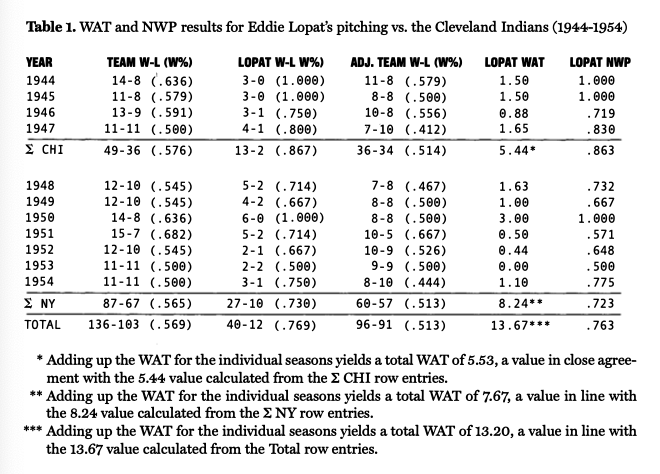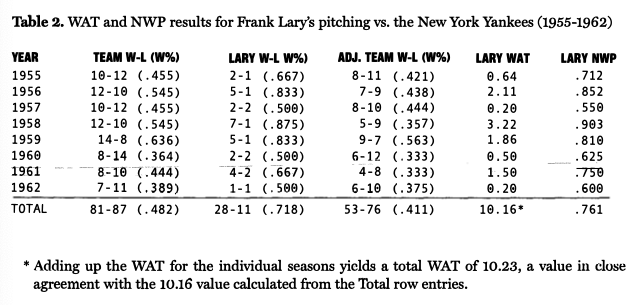Normalized Winning Percentage (NWP): Eddie Lopat vs. the Indians, Frank Lary vs. the Yankees
This article was written by Herm Krabbenhoft
This article was published in 2003 Baseball Research Journal
It was recently reported that Eddie Lopat, who pitched for the Chicago White Sox, the New York Yankees, and the Baltimore Orioles, compiled a phenomenal 40-13 W-L record versus the Cleveland Indians during his major league career (1944-1955).1 For the years that he was a full-time, full-season player (from 1944 through 1954), his W-L record against the Tribe was 40-12 (which yields a .769 winning percentage). How does this exceptional individual performance compare with that achieved by Lopat’s mound mates as a group?
To answer that question, one can make use of “Normalized Winning Percentage” (NWP). NWP, devised by Bill Deane in 1983, projects how a pitcher might perform on a .500 team, thus putting all hurlers, past and present, on an even plane of comparison.2
NWP is defined in Equation 1, where WAT is the pitcher’s Wins Above Team, and PD is the Pitcher’s Decisions (i.e., wins plus losses). WAT is the number of wins a pitcher garnered beyond those expected of an average pitcher for that team.3 WAT is defined in Equation 2, where P% is the pitcher’s winning percentage and T% is the team’s adjusted winning percentage (i.e., the winning percentage obtained after subtracting the pitcher’s wins and losses from the team’s overall wins and losses).
My reason for wanting to determine Lopat’s NWP versus the Cleveland Indians arose from my interest in Frank Lary’s spectacular won-lost record versus the New York Yankees.4 Lary (known as “The Yankee Killer”) twirled for the Detroit Tigers and fashioned an amazing 28-11 W-L ledger (which affords a winning percentage of .718) against the perennial pennant winners during an eight-year stretch (1955-1962).5
Based on standard winning percentages, Lopat (.769) seems to have been somewhat better versus the Indians than Lary (.718) was against the Yankees. Accordingly, I was curious how their corresponding Normalized Winning Percentages would compare.
Table 1 collects the pertinent WAT and NWP results (obtained via a Microsoft Works spreadsheet treatment) for Eddie Lopat versus the Cleveland Indians in the 1944-1954 period. Table 2 collects the pertinent WAT and NWP results (obtained via a Microsoft Works spreadsheet treatment) for Frank Lary versus the New York Yankees for the 1955-1962 period.
Inspection of Table 1 reveals that without Eddie Lopat on the mound, his teams (either the White Sox or the Yankees) were better than .500 against the Indians, .514 and .513, respectively. During Eddie’s tenure with the Pale Hose (1944-1947), which includes two World War II seasons, his NWP against the Tribe was a glowing .863. And for his full-time string with the Pinstripers, his NWP was an impressive .723. Overall, he produced a NWP of .763.
Examination of Table 2 suggests that Frank Lary’s NWP performance against the Yankees (who captured the AL pennant in seven of the eight years from 1955 through 1962) was virtually the same as Lopat’s versus the Indians. “The Yankee Killer” compiled a fantastic .761 NWP in his confrontations with the Bronx Bombers. The Tigers, on the other hand, without Lary on the hill had a dismal .411 winning percentage against the Yankees.
So, in summary, it is seen that Lopat and Lary each outperformed their collective mound mates — in an enormous way — in their respective battles against the Indians and Yankees, achieving nearly identical NWPs of .763 and .761, respectively.
As a kid, HERM KRABBENHOFT attended and scored four games that Frank Lary pitched against the Yankees (at Briggs Stadium).
Acknowledgments
Thanks to Bill Deane for his interest and helpful comments on my NWP research.
Notes
1. Spatz, Lyle.”Ed Lopat and the Cleveland Indians,” SABR Committee newsletter, p. 1 (February 2003); the material presented was based on contributions from Steve Gietschier, Pete Palmer, and Zita Carno.
2. Deane, Bill. “Normalized Winning Percentage,” The Baseball Research Journal, No. 25, pp. 42-44 (1996), and “Normalized Winning Percentage Revisited,” By the Numbers, vol. 9 (No. 2), pp.6-7 (May 1999).
3. Thorn, John, Pete Palmer, and M. Gershman, eds., Total Baseball, 7th ed., Total Sports Publishing, Kingston, NY, p. 2,501.
4. Krabbenhoft, Herm. “The Phenomenal Achievement of Frank Lary: Premier Yankee Killer,” Baseball Quarterly Reviews, vol. 1 (No. 3), pp. 65-81 (Fall 1986).
5. In an injury-plagued 1963 season, Lary was 0-2 against the Pinstripers, which gave him a career 28-13 W-L mark versus the Bronx Bombers. In the 1964 season, Lary started with the Tigers (and did not face the Yankees), but was sold to the New York Mets and then traded to the Milwaukee Braves. In 1965 (Lary’s last season in the majors), his contract was again purchased by the Mets, who later traded him to the Chicago White Sox (with whom he faced the Yankees three times, each a relief appearance, and had no decisions.





